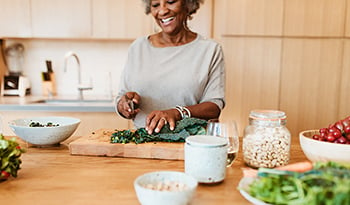Easy Tips for Healthy Eating During the Holidays
DISCLAIMER:This blog does not intend to provide diagnosis...
- In this article:
- Try Preparing Most Holiday Meals at Home
- Tips for Choosing Healthier Food Options
- Reduce Refined Sugars During the Holidays
- Freeze Baked Goods and Other Holiday Gifts
- Tips for Practicing Portion Control
- Eat Mindfully During the Holidays
- Bring a Healthy Dish to Parties and Family Gatherings
- Make Homemade Desserts With Healthy Recipes

With all the hustle and bustle of the holiday season, it's especially important to be mindful of eating habits. From incorporating more whole foods to freezing tempting treats and whipping up healthier homemade alternatives, there are many ways to be more mindful of healthy eating this time of year.
Try Preparing Most Holiday Meals at Home
Meeting up with family and friends who are in town for the holidays can mean eating a lot of your meals out. But choosing to cook meals at home gives you full control over the ingredients and nutritional content - which might be better for both the body and the wallet.
To make cooking at home easier during this time of year, try meal prepping on the weekends for use during the week. Comforting casseroles, hearty stews and soups, and flavorful salads can all be prepared in advance and can quickly be heated up and served. Read our pantry meal prep staples article and stock up on the essentials.
Tips for Choosing Healthier Food Options
Many holiday favorites are based around rich, heavy foods, with overly processed ingredients. Whole foods such as legumes, beans, whole grains, nuts, and seeds have improved nutritional profiles and are often much more nourishing than processed, heavy meals.
To incorporate healthier food options into the day, start by choosing whole-grain bread instead of white bread. Also use brown rice instead of white rice as it provides up to 3 grams of additional fiber per serving. Research has shown that increased fiber intake may improve weight control.
As a snack, try having a handful of nuts or seeds in place of a cookie. Nuts provide healthy unsaturated fats, omega-3 fatty acids, and antioxidants. Scientific studies have concluded that moderate nut intake could reduce cholesterol and protect against heart disease.
Since beans are a high-fiber food, they provide a calorie-saving alternative to meat. Try using them as a base for a vegetarian stew. Dried beans are less salty, and softer in texture than the canned varieties. Lentils have a meaty texture that makes them an ideal substitute for meat in soups and casseroles, as well.
Reduce Refined Sugars During the Holidays
Sugary sweets are everywhere around the holidays. Unfortunately, research suggests that too much refined sugar could drive weight gain and contribute to digestive issues. Consider monitoring sugar intake with a food tracking app. These programs help users identify patterns in nutritional habits and can provide insight on what might need to change.
Baked goods such as chocolates, cookies, cakes, and muffins tend to have a very high sugar content. Try to save them for a treat once in a while and store sweets out of sight to reduce temptation. Consider making healthier baked goods at home by using applesauce, dates, or stevia as alternatives to cane sugar. Aim to choose high-quality dark chocolate instead of milk chocolate. In general, dark chocolate has more flavor and is more nutritionally rich.
Many holiday juices and drinks are also high in sugar. To combat this, try to eat a piece of whole fruit instead of drinking fruit juice or a smoothie. Or try to make your own using healthy sweetener alternatives such as stevia, raw honey , xylitol, monk fruit, or coconut sugar.
Freeze Baked Goods and Other Holiday Gifts
People are often inundated with food gifts over the festive season, and keeping these items out in the kitchen typically increases the temptation to overindulge. Fortunately, classic holiday sweets such as cinnamon rolls, fudge, chocolate, brownies, and cookies all keep well in the freezer.
When sweets arrive, simply place them in a freezer-safe container and pop them directly into the freezer. Freezing goodies could help control sugar cravings more effectively than placing the sweets in the refrigerator or cupboard. Frozen food must unthaw, which generally takes several minutes, before it can be eaten. Most sugar cravings subside in a maximum of 15 minutes, especially if individuals distract themselves with other activities. By the time the sweets defrost, the craving could be gone.
Frozen baked goods can be saved for later in the season and may be helpful when preparing dishes for last-minute holiday parties.
Tips for Practicing Portion Control
Practicing portion control is particularly important during the holiday period when people tend to eat a lot of rich foods. While it may be impossible to know how many calories are in a slice of grandma's pie, choosing to cut a regular portion in half could help in reducing overall calorie and sugar intake.
At holiday gatherings, use a salad plate for the meal instead of a regular dinner plate for easier portion control. Another option is to split meals with a friend or save half of the meal to take home.
Eat Mindfully During the Holidays
Eating mindfully can help individuals slow down during the holiday season, and it might also make eating a more enjoyable experience. Instead of absentmindedly rushing through meals, adopting mindfulness techniques helps people savor the smells, textures, and tastes of each bite. This often results in less overall calorie intake and a more satisfying meal.
During the holiday season, people are sometimes so busy that they eat standing up or while working or talking on the phone. To take a more mindful approach to food, try sitting down at a clean table to eat, and turn off phones and entertainment devices during mealtime. If possible, nutritionists suggest creating a set time for all meals and eating in the same place each day.
Mindful eating also involves differentiating between emotional hunger and physical hunger. Rather than eating in response to boredom, anxiety, or sadness, individuals who practice mindful eating learn to eat when they are physically hungry. Growling of the stomach and low energy levels are signals of physical hunger. Learning to eat only in response to these signals can improve a person's relationship with food during the holidays and throughout the year.
Bring a Healthy Dish to Parties and Family Gatherings
From family gatherings to office parties with co-workers, social engagements tend to increase significantly during the festive period. The food at these events tends to be greasy and sugary, and healthy options might be hard to find. As a result, partygoers may find themselves eating food that they don't really want or need.
To remedy this situation, bring a healthy dish to share at the gathering. Doing so improves control of ingredients, allergens, calories, and overall nutrition and will ensure you with a healthy meal option.
Make Homemade Desserts With Healthy Recipes
Holiday desserts often include preservatives, potential allergens, and pre-packaged ingredients of little nutritional value. To prevent possible stomachaches that could come from eating these unfamiliar, overly rich foods, try these recipes for healthy holiday desserts.
Baking at home is an ideal way to sneak in more vegetables, too. For example, brownies can be made using sweet potatoes or black beans for a smooth texture, and avocado provides a creamy base for chocolate mousse. For a healthier homemade hot chocolate recipe, try using cacao powder and a natural sweetener in place of refined cocoa or hot chocolate mixes.
Using spices such as allspice and cinnamon can give everyday foods a holiday twist. Additions like peppermint, orange extract, and ginger offer flavor without adding too many extra calories. When making pies, opting for spelt flour lends a sweet, nutty flavor. This type of flour has more fiber, niacin, iron, and zinc than wheat flour.




